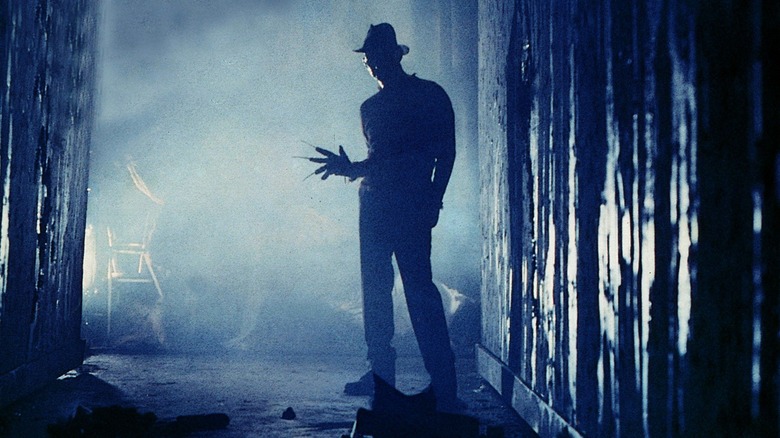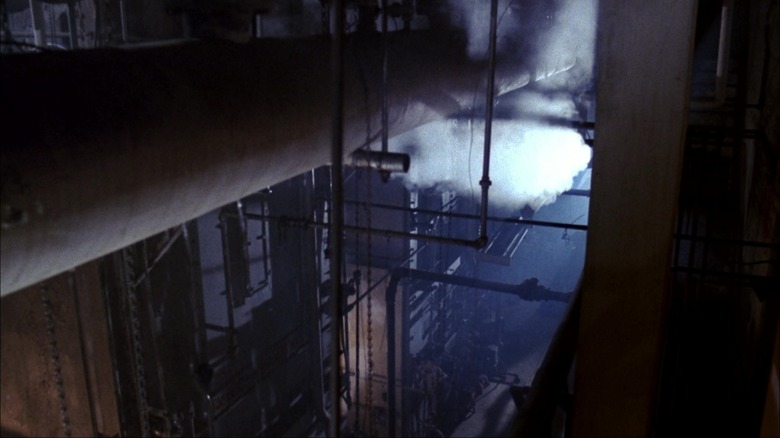The VFX Wizard Behind Freddy Krueger's Glove Changed A Signature Horror Special Effect Forever
In the opening credits of Wes Craven's 1984 horror classic "A Nightmare on Elm Street," the evil child murderer Freddy Krueger (Robert Englund) is seen hiding out in a remote boiler room, carefully constructing his preferred mode of violence: a glove outfitted with long blades on the fingertips. Freddy uses his glove to slash through the innocent flesh of his victims, giving him an animalian, predatory nature. When he wears the glove, he is ready to kill — and he never removes it.
Freddy's glove, charred face, striped sweater, and rumpled hobo hat became the monster's signature look, and millions of horror fans have recreated Freddy's costume every Halloween since. Naturally, one can buy replica plastic Freddy gloves at costume shops, even to this day.
Freddy's glove was designed and built by Jim Doyle, a mechanical SFX wizard who was just starting out in 1984. "Nightmare" was only his third film (after "Flicks" and "Dreamscape"), but he provided a lot of revolutionary visuals that stick in the brain. In both "Nightmare" and his next film, "Breakin' 2: Electric Boogaloo," he oversaw rotating sets that, when mounted with a camera, allow actors to appear like they're crawling on walls and ceilings. He also worked on the notable horror sequels "Hello, Mary Lou: Prom Night II," "Friday the 13th Part VII: The New Blood," and "Ghoulies Go to College."
More widely used than his creature designs, however, was Doyle's invention of the dry fogger, a novel new fog machine that could be blasted at room temperature. Dry foggers are now industry standard — used wherever one might see a hazy frame, a foggy rock 'n' roll concert, or a haunted house. One can even buy them in Halloween stores. Doyle won a Technical Academy Award for its invention, and he talked in more detail about the dry fogger in a 2015 interview with the University of Colorado, Boulder.
Nightmare fog, hold the ice
Doyle worked on the famous music video for Michael Jackson's "Thriller," a video that contained a lot of monsters and makeup effects, and a heck of a lot of fog. In the old days, Doyle said that on-screen fog was typically created by liquid nitrogen, a substance that (as anyone who has seen "Terminator 2: Judgment Day" knows) freezes solid matter on contact. Doyle, tired of working on sets that were literally freezing, felt there might be a less corrosive fashion to create clouds. "We used tons of liquid nitrogen, which froze the set solid for 20 hours," he said, "The guys had a terrible time breaking it apart. I thought, 'There has got to be an easier way to do that.'"
Doyle took a fog machine home with him, and tinkered with it in search of a solution. He discovered that if he blasted dry nitrogen onto a hot water source, particles would condense together in a safe, room-temperature, dry cloud. Thus, the modern fog machine was born. Doyle explained:
"This device provides an atmosphere at 100 percent relative humidity, so it is wringing all the fog possible per unit of [nitrogen]. [...] The bigger the machine, the more efficient and controllable it becomes. Theoretically one could make one the size of a semitrailer."
He tried out the new version of the fog machine to the TV series "Kids, Inc.," and it worked like a charm. Soon thereafter, he was contacted by Alice Cooper, who wanted on-stage fog for extended musical numbers. Liquid Nitrogen and dry ice certainly weren't going to cut it, so Doyle employed his new fog machine, and it was a wild success. Since then, thousands of movies and music videos have made use of Doyle's invention. Fog machines are standard issue.
Doyle hasn't worked on a film since 1996 (when he provided technicals for "The Nutty Professor"), but he has continued to provide fog, smoke, fire, and ice effects for high-profile live performances like Cirque du Soleil's "Le Rêve," and the opening ceremonies for the Olympics in 2002 and 2014.
It's astonishing to think that Freddy Krueger's glove is one of Doyle's smaller achievements.

